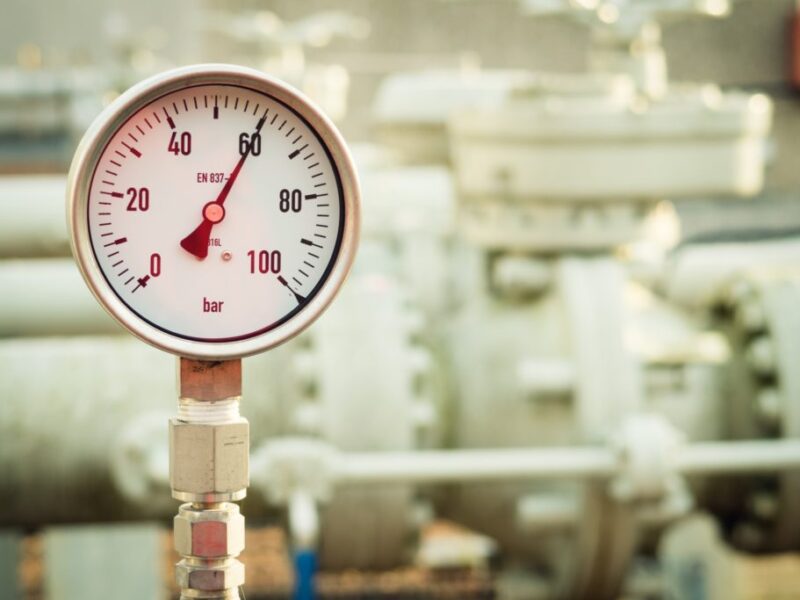
The oil and gas industry has experienced rapid growth in new technologies. As a result, many new devices have been developed to complement the current ones. One of those is the pressure gauge. What is a pressure gauge? It’s just an instrument used to measure pressure in oil and gas production industries. Pressure gauges are widely used in water, gas, steam, and crude oil pipeline networks because they help prevent damage caused by high pressures and temperatures.
Pressure gauges are an essential piece of equipment in any production facility. These gauges measure the pressure, temperature, and other measurements directly affecting oil or gas production. Unlike most tools made for workers on the production floor, pressure gauges can provide a valuable look at the equipment and help identify potential failures before they lead to significant problems or even shut down production for good.
Pressure Gauge Basics
Pressure gauges are used throughout a pumping lease, with various sizes, costs, and accuracy levels. Some meters can take more abuse but are generally less accurate. Others are more accurate but need to be treated with more care.
When it comes to gauges, less is more. While this may sound counterintuitive, it’s true—especially when considering the wide variety of tasks for which gauges can be used. For instance, a specific gauge can monitor the pressure in a flow line and help ensure no leaks. And another gauge can be used at the wellhead to measure actual pressure in the pipeline.
However, if you want accurate measurements across all those tasks, you should choose a gauge designed for each. But before deciding on which gauge might work best for your specific application, there are some things you should know about how gauges work and why they do what they do.
The most common gauge type uses springs to move the hand on its face, indicating pressure. Another type is called a Bourdon tube. It is a thin, flat tube bent into a C shape. As pressure builds in Bourdon’s tube, it attempts to straighten itself out of its curved shape. Again, this moves the hand on the gauge’s face, indicating the pressure.
Types of Gauges
If you’re working with high-pressure equipment, it’s essential to use a gauge that has built-in safety measures. A standard gauge can blow out if it needs to be stronger. This can cause injuries or even death for the people nearby. You should also consider using a gauge with a rubber plug in the back of the gauge, which will blow out if the pressure becomes too high. Otherwise, safety glasses should be worn when opening a gauge or reading a valve on a high-pressure line.
Gas-filled gauges are a common sight on most applications, but they can have a problem: over time, they can become scratched and difficult to read. On the other hand, liquid-filled gauges will remain readable much longer but may have a bigger problem with corrosion.
Calibration and Well-Testing Gauges
Gauges work the same as any other gauge. They are just generally more accurate and can be calibrated.
A test gauge will have an adjustment screw with which any error of the indicator needle can be corrected. Then, using a deadweight tester, the gauge can be checked for accuracy. Well-testing gauges are generally relatively expensive and should be treated gently. A cam and roller gear gauge is a good option, as it is durable and accurate. It’s also usually best to select gauges with the hand pointing directly up when indicating the middle of the pressure range. Indicators of this type are more reliable. Occasionally it may be necessary to have a gauge calibrated at a laboratory, or by the factory, in situations when precision is essential.
Calibrating a test gauge requires a deadweight tester. To calibrate a gauge using the deadweight tester, the black gauge on the left rear must be closed. Next, the black valve in the front left should be opened and the handle cranked up. Hydraulic fluid from the center reservoir will be pulled under the crank’s plunger. Now the two valve states are reversed, with the front valve being closed and the back opening. Cranking the handle downward puts pressure on the fluid to push it to the center pedestal stem. You can mount the gauge on the tester, then, place the amount of test weight on the base in the center. The left screw raises the weights to the correct height, and you can then check the gauge to see if it reads accurately. The meter needle can be adjusted with a screwdriver.
Pressure Measurement without a Gauge
Pressure measurement without a manometer deadweight tester can also measure pressure directly when you need an exact reading. For example, using a small-diameter, high-pressure hose, the tester can be connected directly to the wellhead. The tester can then be used to measure the pressure.
Conclusion
Understanding the role and advantages of pressure gauges in oil and gas production will go a long way toward achieving the goal of increased productivity from your wells. It’s a long-term investment into the well involved but an entirely worthwhile one that provides value to other departments within your company. If you have any questions, please feel free to contact [email protected], or you can visit our website at www.bcstgroup.com.






